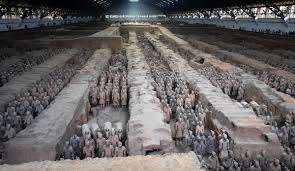
The Terracotta Army
A Silent Guardian for Eternity
The Terracotta Army is a collection of terracotta sculptures depicting the armies of Qin Shi Huang, the first emperor of China. It is a form of funerary art buried with the emperor in 210–209 BCE with the purpose of protecting him in his afterlife.
A Glimpse into Ancient China
The figures, dating back to the late third century BCE, are located in three pits within the Emperor Qin Shi Huang's Mausoleum in Lintong District, Xi'an, Shaanxi province, China. This incredible site remained hidden underground for centuries until its accidental discovery by farmers in 1974. The unearthing of the Terracotta Army instantly became a significant archaeological find, offering a priceless glimpse into ancient Chinese civilization.
The Army's Composition
The army is a vast collection of life-sized terracotta figures, estimated to number over 8,000 soldiers, 130 chariots with 520 horses, and 150 cavalry horses. The figures are incredibly detailed and lifelike, each with unique facial features, hairstyles, and armor, showcasing the advanced craftsmanship of the Qin Dynasty.
- Infantry: These soldiers stand in various poses, armed with spears, swords, and crossbows, representing the backbone of the Qin army.
- Archers: Kneeling and standing positions characterize the archers, showcasing their readiness for battle.
- Charioteers: These figures stand on elaborate chariots, ready to lead the army into battle.
- Generals: Distinguished by their elaborate headdresses and armor, these figures represent the leaders of the Qin army.
- Horses: The cavalry and chariot horses are equally impressive, depicted with great anatomical detail, capturing their strength and power.
The Significance of the Terracotta Army
The Terracotta Army is not just an extraordinary collection of ancient sculptures; it holds immense historical and cultural significance.
- Historical Significance: It offers invaluable insights into the military organization, weaponry, and warfare tactics of the Qin Dynasty. The meticulous details provide researchers with tangible evidence of ancient Chinese military practices and the social hierarchy of the time.
- Cultural Significance: The army reflects the Qin Dynasty's obsession with immortality and the afterlife. It symbolizes the emperor's power and his desire to rule even in the afterlife. The sheer scale of the project showcases the impressive organizational skills and resources of the Qin empire.
The Terracotta Army Today
Today, the Terracotta Army is a UNESCO World Heritage site and one of the most popular tourist attractions in China. The site houses three pits where visitors can marvel at the figures, along with a museum showcasing excavated artifacts. The Terracotta Army serves as a reminder of the power and grandeur of ancient China, captivating visitors with its magnificence and historical significance.
FAQs:
1. What is the purpose of the Terracotta Army?
The Terracotta Army was designed to protect and serve Emperor Qin Shi Huang in the afterlife, reflecting the belief in the continuation of life after death.
2. Were the Terracotta Warriors buried alive?
No, the Terracotta Warriors were not buried alive. They are clay sculptures created to accompany the emperor in death, not living people.
3. Why is the Terracotta Army so famous?
The Terracotta Army is famous for its massive scale, the lifelike detail of the figures, and its significant historical and cultural value, offering a unique window into ancient Chinese civilization.